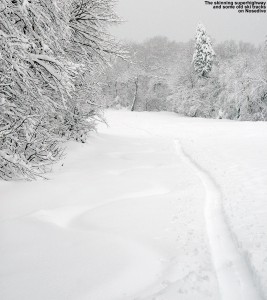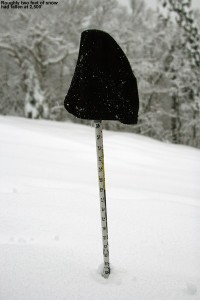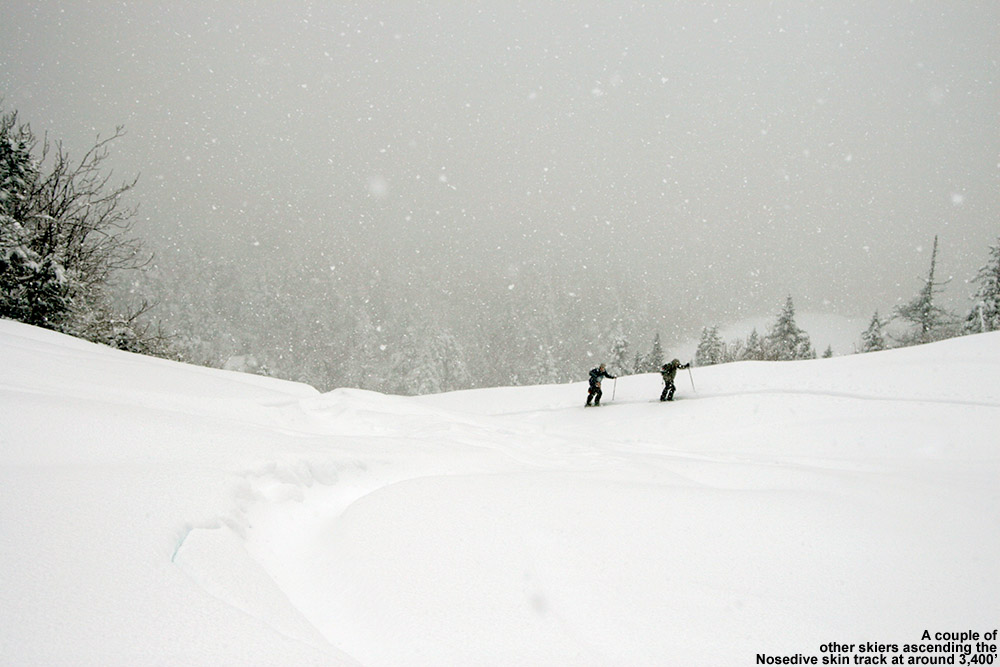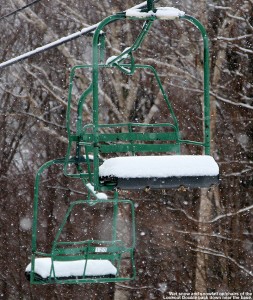
A cutoff low pressure system backed into the region yesterday, and it began to dump a mixture of heavy snow in the mountains and pouring rain in the lower mountain valleys of Northern Vermont. Meanwhile, in the Champlain Valley it was just dry and cloudy, so it made from an impressive scene; at the American Weather Forum I sent in a post with a mid afternoon picture from Burlington showing the wall of snow in front of the mountains. Powderfreak headed up to Mt. Mansfield yesterday afternoon and sent in a nice collection of snowy pictures from his trip. He reported that the mountain had already received a foot of snow by that point, and the radar showed that moisture continued to pour into the area. When the precipitation data from the Mt. Mansfield Stake came in, it indicated that the mountain had already received roughly two inches of liquid equivalent by the late afternoon. The snow and rain just kept pouring down all evening and right through to this morning, and we’d picked up over an inch of liquid at the house as of 6:00 A.M.
I had some time earlier today, so I headed off to Stowe to check out the new snow and make some turns. The temperature was in the upper 30s F through the valleys, so the precipitation was all rain, and it was literally pouring at times. Snow started to mix in with the rain up around 1,200’ as I ascended toward the Stowe Mountain Resort Cross Country Ski Center, and it quickly changed over to all snow by the time I’d reached the Inn at the Mountain a few moments later. The precipitation was wet snow as I parked at the Midway lot (~1,600’) and the accumulation was a couple of inches. The snowflakes were small, in the 1-3 mm range, but it was coming down fairly heavily and I quickly had to put on my ski jacket to avoid getting soaked.

There were a few cars in the lot, and to begin my ascent I followed the collection of boot prints and skin tracks that led toward Nosedive; I definitely wanted to find an established skin track, because it sounded like the couple of inches in the parking lot was quickly going to turn into a lot more in the higher elevations. And indeed it did – within just a couple of minutes after leaving the lot, I was walking through several inches of fresh snow, so I put on my skis and hopped in the skin track. I was immediately thankful for the skin track, which felt like a superhighway since it was made by some pretty fat skis. With that great skin track in place, the ascent was smooth and fast, and as I continued to check the depth of the new snow with my measurement pole, I was astonished at how quickly it increased. By 2,000’ the depth of the snow was already 11”, and by 2,500’ it was 24 inches. That meant that it was essentially increasing by a couple of inches every 100 vertical feet, and if that level of increase kept up, there was going to be four feet of new snow at the top. However, the depth of the snow stopped increasing at 2,500’, and remained right around two feet from there on up.
I saw a couple of other guys on the skin track during my ascent, and talked to one of them when we both stopped near the top of Nosedive. He said that he was one of the guys that set the skin track this morning, and I thanked him a lot for that because it was fantastic. He said it was tough, but that the second person in line really had it easy because the dense snow compacted so well, so he and the guy he worked with switched off pretty frequently because the back person was rested so quickly. He had just done a lap down to the 2,500’ level, and said that he felt that was a bit low to go to stay in the best snow; ending a few hundred feet higher would be better.
The wet snow that had been falling heavily throughout the ascent was giving my Gore Tex quite a workout, but there was no wind and temperatures were very comfortable in the 30s F, so various vents and flaps on my gear were open to keep cool. As I crested the last part of Nosedive though, winter came roaring in, with the wind picking up a bit, the temperature dropping below freezing, and all the moisture that had accumulated on my gear during the ascent freezing into crustiness. These are the days when you really appreciate those high-tech waterproof breathable fabrics though, because things were nice and dry on the inside.

I stopped at the top for a few minutes, and there were several folks using the new ski patrol building at the top of the Fourrunner Quad for a quick break. Overall the snow was still just a couple feet deep, but there were a few drifts, and at one point while I was out of my skis, I stepped down and sank up to my waist in powder. The snow was still fairly dense even up around 3,700’, but bigger flakes were falling and it was overall a notably drier environment than the lower elevations.

For my descent, I headed down in the direction of Hayride; I was unsure how this dense snow was going to ski, but I figured Hayride was a reasonable, steep piece of terrain to keep me moving if necessary. After my first few turns I could tell that this snow was going to be challenging on my midfat Telemark skis. It was bottomless Sierra Cement/Cascade Concrete, and it definitely required a certain level of finesse on the Teles. I’ve been used to skiing fairly dry Vermont powder all season, so it took a couple of impressive flops before I dialed in my technique and started to cruise through the dense snow. I was reminded of a day in December 2001 that E and I skied similar snow at Schweitzer Ski Resort in Idaho – they’d just received four feet of Cascade Concrete, and people were flopping all over the place on the trails, sometimes taking several minutes to extricate themselves each time. We were on alpine skis at the time, so things were a bit easier, but there’s no question that bottomless dense snow can be a challenge to ski. A group of three snowboarders passed by me on their descent, and watching them, I thought about how nice it would be to have my snowboard, but it would have been a pain on the ascent. I was happy to find that my turns were smooth for a while, but between the 2,500’ and 3,000’ level the snow began to get wetter, and I had to work harder and harder to keep my stance dialed in. Below the 2,500’ mark the skiing was a bit “survival style”, with the focus on just on keeping that perfect balance on each turn. There was actually another change in the snow that made things a bit easier below that point (perhaps dense enough that one didn’t sink in much at all) but as I approached the Crossover trail, the snow began to change once more as it really got slushy and difficult to do much more than straight line it. I rode Crossover back over to the Gondola base – it continued to snow even down that low in elevation, but I could tell that it was wetter than it had been at the base in the morning. Back at the car I chatted with Powderfreak, who had just arrived for some turns. I let him know about the nice skin track on Nosedive, and at one point he mentioned that there could be more snow coming into the area tonight.
I’m going to be home with the boys over the next few days, so I’ll have to decide what skiing to do with them. If the texture of the snow doesn’t tighten up a bit, Telemark skiing will be very challenging for them, so we may have to think about getting in some lift-served turns on their alpine skis. Jay Peak is running their lifts, and they’re reporting 15 inches in the past 48 hours. Killington is also offering lift-served skiing, and they’re reporting 19” in the past 48 hours. With Stowe already at 24 inches as of this morning, and precipitation continuing to fall, it will be very interesting to see where the storm totals end up over the next couple of days. There’s been a nice recovery of snowpack at the Mt. Mansfield Stake, as of this evening there’s been about 3.5 inches of liquid equivalent from this storm, and the snowpack at the stake is back up to almost 50 inches. This storm system has really felt like a classic Pacific Northwest-style dump though, with heavy valley rains, and lower elevation wet snow gradually morphing into dry, but still dense snow at elevation. I can certainly say that when I got back to the house this morning, my ski clothes felt like they’d taken a trip to the Pacific Northwest, and a good period of drying was definitely in order. They’re ready to go out into the storm again though, and so am I.







